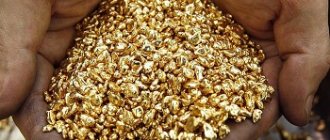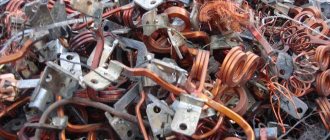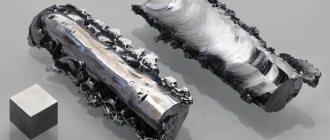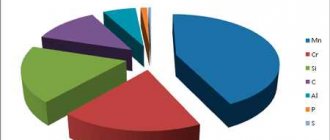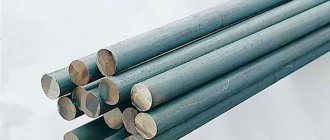How do ferrous metals differ from non-ferrous metals?
The above list is exhaustive for magnetic chemical elements (ferrous metals). If you make a combined list of non-ferrous and ferrous metals, it will include 78 chemical elements of the periodic table. At the same time, three types of ferrous metals, with the exception of iron, are also classified as non-ferrous according to certain characteristics. They are divided into types:
- heavy - copper, zinc, lead, tin, this also includes nickel;
- light – aluminum, titanium, magnesium and others (12 elements in total);
- refractory – manganese, tungsten, molybdenum, chromium and others (8 elements in total);
- noble, etc. (total 8 groups of non-ferrous metals).
It is much more difficult to list everything that relates to ferrous metals from a technical point of view. The total number of steel and cast iron grades includes several hundred product items. Moreover, some of them do not have magnetic properties, which allows, based on the combination of characteristics, to classify such alloys simultaneously as ferrous and non-ferrous metals.
Is steel a ferrous or non-ferrous metal?
The question of whether steel belongs to ferrous or non-ferrous metals should be considered based on the classification of carbon alloys, which is provided for by many GOSTs.
According to various regulatory documents, steel is divided into the following types of ferrous metals:
- low-carbon, carbon and high-carbon alloys with a carbon content of up to 0.25; 0.25–0.6 and over 0.6%, respectively;
- low-alloy, medium-alloy and high-alloy grades of alloys with a controlled content of alloying additives up to 2.5; from 2.5 to 10 and over 10%, respectively;
- structural, tool, high-speed, corrosion-resistant, heat-resistant and other types of steel for various applications.
Of the entire extensive range of steel grades, only seven items form the group of non-magnetic alloys. We remind you that the absence of magnetic properties is the main characteristic of non-ferrous metals. At the same time, non-magnetic steel grades contain iron, which is one of the defining characteristics of ferrous metals.
Taking into account the small number of non-magnetic steels, they can be considered an exception to the general rule with an unclear status. From an ordinary point of view, it is generally accepted that ferrous metals are alloys that are susceptible to corrosion from atmospheric influences. Although high-alloy alloys can also rust.
Black steel - classifications, characteristics, application
Black steel is used in mechanical engineering. This is an iron-carbon alloy of ordinary quality. The material meets all technical requirements of the current GOST 380-94 (grades are also indicated here). This is the most important structural material used in technology and industrial production. The alloy has high performance characteristics. Thanks to easy mining and relatively simple smelting of black steel, an inexpensive material is obtained that is widely used in industry and mechanical engineering.
Classifications and main scope of application
There are two main types of ferrous steel according to the method of obtaining rolled products (the regulated characteristics are divided into 6 main categories and are indicated by a digital combination):
Hot rolled. This group includes:
- varietal,
- shaped,
- thick sheet,
- thin sheet,
- broadband steel (often called universal steel)
Is titanium a non-ferrous or ferrous metal?
Titanium is used in the production of high-strength and heat-resistant alloys, and also as an alloying additive to carbon steel grades. In titanium alloys, the titanium content ranges from 85 to 99.5%. The main additives in them are aluminum, vanadium, molybdenum, manganese, zirconium. Titanium is included in the group of light non-ferrous metals along with aluminum and other chemical elements.
Titanium-based alloys also unconditionally belong to non-ferrous metals. They are used for casting and production of a wide range of metal products: sheet metal, pipes, profiles, foil, forgings, stamped blanks, etc. Small additions of titanium to carbon steel give the alloys increased strength and other special properties.
Is lead a non-ferrous or ferrous metal?
Lead is part of the group of heavy non-ferrous metals. Currently, its use in its pure form is extremely limited. Examples include radiation protection devices at radioactive sites and the production of bullets. But it is widely used in the form of various alloys in the production of explosives, batteries, dyes and other products.
Is cast iron a ferrous or non-ferrous metal?
We remind you that the main difference between ferrous and non-ferrous metals is the presence or absence of magnetic properties. There are several grades of non-magnetic cast iron, for which nickel, manganese, silicon and chromium are used for alloying. The entire range of cast irons is divided into white, gray, malleable, high-strength and pig alloys. The absolute majority of them are cast irons with magnetic properties.
Cast iron is used in foundries, and only pig iron is used for subsequent steel smelting. Basically, cast iron is a ferrous metal, but non-magnetic alloys have a dual nature, which allows them to be classified as both groups of metals. By the way, some brands of alloy cast iron are also susceptible to corrosion under atmospheric influences.
Aluminum is a non-ferrous or ferrous metal
Aluminum is the most common non-ferrous metal. In terms of content in the earth's crust, it is 3.5 times higher than iron. Aluminum in its pure form and alloys based on it are widely used in the production of a huge range of products. There are eight systems of aluminum alloys based on their basic composition:
- aluminum-copper-manganese;
- aluminum-magnesium;
- aluminum-zinc-magnesium, etc.
Without exception, all aluminum alloys also belong to the group of non-ferrous metals. In addition, aluminum is widely used for alloying carbon alloys (steel and cast iron) to give them special properties. This equally applies to most other alloying elements among non-ferrous metals.
Where are recycled ferrous metals used?
First of all, it is worth noting that the scope of application of recycled scrap metals is quite wide precisely because recycling is much cheaper than manufacturing from ore and requires less time. Most large and small enterprises have long abandoned ore mining in favor of a cheaper and less expensive method of processing recyclable materials.
As for manufacturing from ferrous metal, it is possible to make anything from it. The scope of application of the material is quite extensive. Ferrous metal is used in agriculture, mechanical engineering, shipbuilding, aircraft and rocketry. Its popularity is due to its high strength, versatility and low cost.
In conclusion, it is worth saying that such a resource as iron is important both for the well-being of processing enterprises and for ordinary people, for whom donating metal is a way to earn extra money.
Copper - non-ferrous metal or ferrous
Copper is not included in the list of 18 chemical elements that make up 99.8% of the mass of the earth's crust, since it belongs to the group of heavy non-ferrous metals. In its pure form, copper is used in the production of various types of rolled copper for general purposes, electrical products and for other purposes.
Copper is the base material in the manufacture of bronze and brass alloys. It is also one of the main alloying elements of carbon steel. Copper is also widely used in the production of non-ferrous alloys based on aluminum and other non-ferrous metals, where it constitutes a smaller proportion of the mass of the finished product.
Copper and alloys based on it, without exception, belong to the group of non-ferrous metals. They do not have magnetic properties. As an alloying element, it can be included in ferrous metals (carbon alloys) to impart special properties to them. But in this case it cannot be considered as a separate type of metal.
Grades of ferrous metals - general information
In addition to the types of metals and their alloys, there are also different grades, and in this article we will look at the main grades of ferrous metals, or rather groups of grades, since in order to consider each type, a whole book will be needed. So, let's start with steel grades. Firstly, these are steel grades for castings - ordinary and with special properties. In total, there are about 60 grades of ordinary steel for castings and about the same number of grades of steel with special properties. As an example, let's take the grade of ordinary steel 20L. In addition to iron, which is about 99% in this steel, the composition also includes (in descending percentage) silicon, manganese, nickel, chromium, copper, carbon, sulfur, phosphorus. This durable steel has no restrictions on weldability. And now about the name. 20L means the steel contains 0.20% carbon, and "L" means foundry.
But, for example, the steel grade for castings with special properties is 15Х23Н18Л. Deciphering the name, we find that this steel contains about 0.15% chromium, 0.23% nickel and 0.18% carbon. Steel grade 15Х23Н18Л is used in industry for the manufacture of corrosion-resistant products that do not require particularly high strength, but can withstand temperatures up to +900 degrees Celsius. We will not give any more examples of specific brands here, since you probably already understand the principle of labeling. It is only necessary to say that, in addition to foundry steels, there are also structural, tool, heat-resistant, stainless, electrical and some special steels - a few hundred grades in total.
Cast iron can be foundry, pigment, gray, malleable, low- and high-alloy, high-nickel, antifriction and with different types of graphite. There are significantly fewer grades of cast iron than grades of steel - just over a hundred. Cast iron, like steel, has its own designations. And here it is worth adding that the situation is complicated by the fact that in the West they use different markings - based on the Latin alphabet, not the Cyrillic alphabet, which is understandable. True, for those who are familiar with the designations of chemical elements in Latin, this will not cause much inconvenience, but the rest will need to remember them in order to be able to correctly select products made of steel and cast iron for their purposes.
metallsday.ru
Is brass a non-ferrous or ferrous metal?
Brass, along with bronze, is one of the main types of copper-based non-ferrous alloys. The range of products made from brass and bronze is almost identical. It includes:
- sheet metal, tapes, foil;
- pipes and tubes;
- wire, rods;
- casting, etc.
Brass and bronze are superior to copper in strength, but unlike it, they are not used for alloying carbon and producing other non-ferrous alloys. Copper-nickel alloys, which are also classified as non-ferrous metals, deserve special attention.
What are ferrous alloys?
The expression itself, ferrous metal alloys, is not entirely correct from a scientific point of view, and here’s why. The fact is that ferrous metals themselves are already alloys, since neither steel nor cast iron are chemical elements, but consist of several elements, at least two: iron and carbon. Iron in such alloys is more than 90%, and carbon is about 2%, while if the alloy contains less than 2.14% carbon, then it is steel, and if it is more, it is cast iron. This number was not chosen by chance - the percentage of carbon above or below this mark greatly affects the physical-mechanical and physical-chemical properties of the alloy, which is clearly seen in the example of steel and cast iron.
The low carbon content in a ferroalloy (which is what ferrous metals are called, since the main chemical element in such alloys is iron) gives the material significantly greater strength, but at the same time makes it less wear-resistant and corrosion-resistant. This is what most steels are like, with the exception of stainless steel, but anti-corrosion protection is provided by the addition of other metals - for example, nickel. If the carbon content of a ferroalloy is more than 2.14%, then such an alloy is less strong, but more wear-resistant and corrosion-resistant. This is exactly what cast iron is. However, there are many types of steel and cast iron, and they differ in the content of other metals - the already mentioned nickel, as well as chromium, manganese, titanium and others.
Separately, it is worth mentioning stainless steels, the anti-corrosion properties of which are imparted by nickel and partly chromium. Nickel actually protects the alloy from oxidation by atmospheric oxygen, and as for classification, stainless steel is often classified not as ferrous, but as non-ferrous metals - at least those steel grades in which the nickel content is equal to or exceeds 8%. So, as we found out, there are no alloys of ferrous metals and there cannot be, since ferrous metals themselves are alloys. Therefore, it is more correct to say not alloys, but types and grades of various ferrous metals - steels and cast irons.
metallsday.ru
Is nickel a non-ferrous or ferrous metal?
In terms of physical properties, nickel is a ferrous metal. However, from a technical point of view, it is classified as a non-ferrous metal. Along with chromium, vanadium, molybdenum, and manganese, nickel is one of the top five alloying elements in terms of their widespread use. In addition, it is used in the production of a wide range of alloys in which it is the main or second element by mass fraction.
These include alloys produced in accordance with GOST 492-73 and GOST 19241-2016. These include cupronickel, chromel, constantan, manganin and other valuable alloys, which are distinguished by very high corrosion resistance. The significant content of nickel and chromium in carbon alloys also provides them with resistance to all types of corrosion, including those resulting from atmospheric and aggressive influences.
Nickel, along with other alloying elements, gives carbon alloys specified special properties. These include heat resistance and heat resistance, increased mechanical strength, resistance to various types of aggressive environments, etc. Taking into account the high value of high-alloy alloys, including those with magnetic properties, they are rightly classified as non-ferrous metals.
Types of ferrous metals | Hand over the metal!
So, we have already found out what classifications of metals exist and which are used in our field, now it’s time to talk in more detail about individual groups of metals, and specifically about ferrous ones. As you know, ferrous metals are also called ferroalloys, so we will use both names to refer to this group of industrial metals and, accordingly, scrap metal. Ferrous metals are divided into two types: steel and cast iron. Also, last time we talked about the fact that for metallurgy, steel and cast iron are not two types of metal, but 2 groups of ferrous metal, and if we are talking about groups, and not about a specific type, then the plural is used: they say not cast iron and steel, but cast iron and steel (however, do not forget that this is professionalism and in literary Russian such word usage, of course, is not very appropriate).
As for steel and cast iron, it is interesting to note that they also have their own varieties and are divided into separate groups, finally uniting individual grades of these metals. Of course, speaking about these groups of ferrous metals, one cannot fail to mention the fundamental difference between cast iron and steel. And it consists of nothing more than carbon content. If it is steel, then it contains up to 2.14% carbon, and if it is cast iron, then it contains more carbon than this value. Why exactly 2.14%? The thing is that when this value is exceeded, the metal radically changes its physical characteristics, which is expressed in the well-known properties of cast iron - this is, for example, increased resistance to corrosion, but on the other hand, increased fragility, especially at low temperatures.
We will not dwell in detail on specific brands of cast iron and steel (there are quite a lot of them), but let’s say a few words about stainless steel: the more nickel it contains, the more expensive it is, and in any case (if there is more than 8% nickel there), it is no longer considered ferrous, but to non-ferrous metals. Accepting this type of scrap metal is, of course, quite profitable, which is why many people pay attention to stainless steel.
metallsday.ru
What is made from ferrous metal?
The boundary separating ferrous and non-ferrous metals does not always look clear and unambiguous. Therefore, at the ordinary level, ferrous metals include carbon and low-alloy steel grades, as well as unalloyed cast iron. We can name the following examples of ferrous metals, or more precisely, products made from them:
- construction fittings of all classes;
- sheet, long and shaped rolled products from the listed steel grades, including those with galvanized coating;
- pipes;
- general purpose steel and cast iron castings - for example, pipeline valve bodies.
The detailed list of ferrous metal products can be continued almost indefinitely. However, do not forget: not everything that rusts is ferrous metal.
